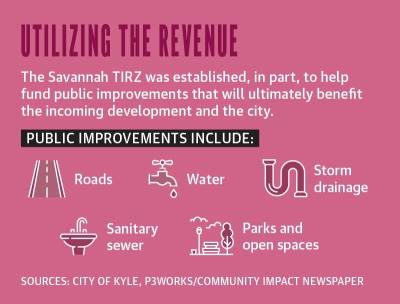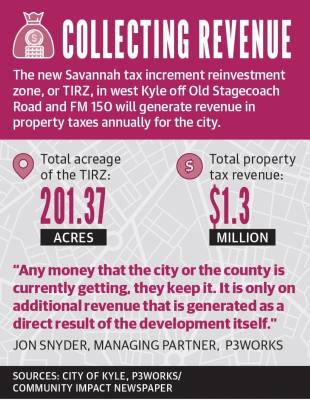The first TIRZ was created in 2004 and is about 275 acres that covers the Home Depot, Target and H-E-B shopping centers along I-35. The second TIRZ was created in 2018 and at 1,480 acres, starts adjacent to the first TIRZ and reaches out toward the city limits of Kyle.
All three TIRZs in Kyle generate property taxes for improvements within each respective zone and for the city.Following months of planning and hours of discussion, the council voted 4-3 against the creation of the 201.37-acre Savannah TIRZ at 1899 Six Creeks Blvd. in Hays County on April 5.
However, the TIRZ was brought back for reconsideration at the following meeting April 19 by a member of the prevailing vote against it, Council Member Michael Tobias, and it was approved in another 4-3 vote in what Mayor Travis Mitchell called one of the most important development votes.
“I decided to bring it back because I felt that this was something that the city could eventually benefit [from] in the long run,” Tobias said. “This has been something that has been worked on for several years now.”
Funding the future
TIRZs are tools utilized by municipalities to help finance economic development, infrastructure, transportation and other projects within the TIRZ boundaries. A board of directors is created to make recommendations to City Council regarding the management and operation of the TIRZ.
A baseline year is established, and the zone receives an appraised value of “taxable real property,” which is $60,050. In 30 years, the appraised value of the land is expected to reach $425,520,136 and to generate $1.3 million annually to the city.
Toll Brothers Development, a commercial property and residential homebuilder, is slated to build about 315 homes within the city’s TIRZ, each of which will send about $3,100 into the city general fund.Those moving into a new home built by Toll Brothers within the TIRZ will be paying the same amount in taxes as those living in other parts of the city, said Jon Snyder, co-founder and managing partner of special district administration firm P3Works.
“That level is frozen for the life of the TIRZ. Then, any new money that is generated as you develop the property and you build houses, the taxable value goes up. Any of those new taxes generated above that base value get divided between the TIRZ and the participating entity,” Snyder said.
With the city and county participating in the TIRZ, both entities will collect a portion of the property tax. Some 36.74% of the city and county tax rate will go toward the TIRZ fund for projects within the boundaries of the district.
The remainder of the property taxes will go to the general fund of each municipality. The city and county, through their respective budgeting sessions, can determine what those funds will be used for over the next 30 years.
“Any money that the city or the county is currently getting, they keep it. It is only on additional revenue that is generated as a direct result of the development itself,” Snyder said.
During the reconsideration of the TIRZ, Tobias said he wanted to dedicate a portion of the property taxes toward projects outside the zone. While a portion of the taxes cannot be set aside in that manner, the council can decide how to spend those funds during the annual budgeting process.
With the deal in place, public improvements throughout the zone include road work, water, sanitary sewer, storm drainage, and parks and open space that will be executed at a cost of $42 million.
Undoing the past
The new Savannah TIRZ was originally formed as a public improvement district in 2015; however, it was created in the extraterritorial jurisdiction of Kyle, meaning the city would not benefit from the development.
“At the time, it was believed that this was the best that we could accomplish,” Mitchell said. “For six years, I’ve been trying to figure out how to undo this deal.”
The creation of the Savannah TIRZ resulted in multiple agenda items tied into one large package deal; take one away, and the whole deal falls apart, Mitchell said.
The deal included a development agreement with Toll Brothers and an interlocal agreement between the city and Hays County. In addition to the dissolution of the original PID, the PID/TIRZ overlay was created in order to keep the tax rate competitive, Snyder said.
“Whatever property owner [that] is going to be within the PID [will be] paying an additional property tax,” Snyder said. “In the case of Savannah, when they looked at what infrastructure they needed to finance, the resulting equivalent tax rate was going to be too high.”The PID/TIRZ overlay will work together and against the property assessments to bring down the property taxes.
Ultimately, the deal was created because there is a significant amount of public infrastructure projects that need to be funded in that area, Assistant City Manager Amber Lewis said.
“Because they are annexing into the city, the city will receive property taxes. If they had not done the PID/TIRZ [overlay], they would not have had to annex into the city, and we would not have gotten any of these improvements or property taxes to help [fund] projects in other parts of the city such as the east side, so it was just a win-win project,” Lewis said.








